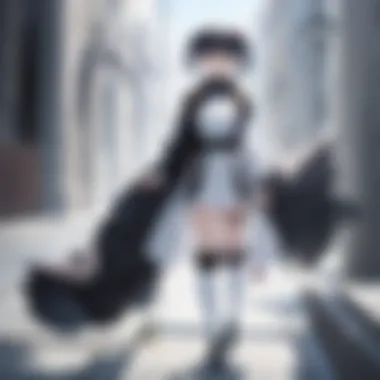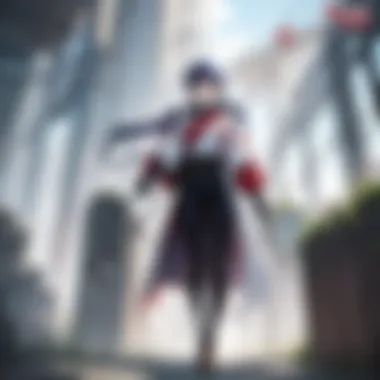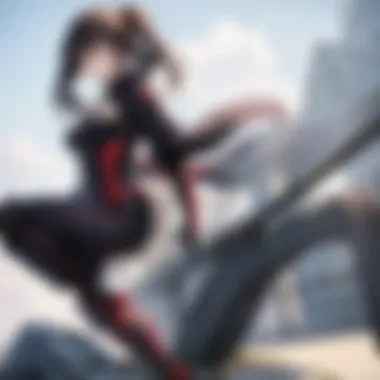Exploring Fence Defense in Anime and Manga Narratives


Intro
In the rich tapestry of anime and manga, storytelling is a nuanced art form. Among the many techniques utilized by creators, fence defense emerges as a significant concept. This strategy involves crafting character decisions that create boundaries or obstacles within the narrative. As characters interact with these fences—be they physical, emotional, or ideological—they reveal deeper layers of their personalities and the thematic weight of the story.
The essence of fence defense lies in how characters navigate their environments. It establishes not only the relationship between characters but also how they react to changing circumstances. Understanding this dynamic can offer audiences a more profound appreciation for the intention behind character development and plot progression.
This article aims to dissect various anime and manga narratives, illuminating how fence defense shapes storylines and enhances character depth. By analyzing key series, characters, and themes, enthusiasts can gain insights that enrich their viewing and reading experience.
Featured Series or Manga
Overview of the Series
Several anime and manga prominently illustrate the concept of fence defense. One notable example is Attack on Titan. Set in a world besieged by giant humanoid creatures, the series encapsulates the struggle against not only external threats but also internal conflicts among characters. The protagonist, Eren Yeager, often finds himself at a crossroads influenced by the very boundaries he aims to overcome. The walls surrounding human civilization serve as both literal and symbolic barriers, prompting discussions about freedom, sacrifice, and the price of survival.
The thematic framework established by the setting encourages viewers to ponder deeper questions about humanity and resilience. This interplay adds complexity to characters’ choices, making their struggles resonate on multiple levels.
Key Characters and Development
In Attack on Titan, characters like Mikasa Ackerman and Armin Arlert exemplify how fence defense shapes development.
- Mikasa Ackerman: Driven by her protective instincts toward Eren, her character showcases the emotional fences that influence her actions. Her growth reflects the tension between personal desires and collective responsibility.
- Armin Arlert: Contrastingly, Armin's intellectual prowess pushes him beyond mere physical defenses. He often navigates moral and strategic boundaries, emphasizing the importance of thoughtfulness in leadership.
Evaluating these characters and their evolution provides insight into the diverse applications of fence defense within the narrative landscape.
Character Analysis
Major Characters
The Major Characters in a series contribute significantly to illustrating fence defense. Characters are not only vessels for action but also reflect the broader themes of the story.
Character Arcs and Growth
Character arcs often depict how individuals confront and redefine their boundaries. For instance, in Naruto, the titular character begins as an outsider, striving to break through social fences. Over time, Naruto learns the value of connection and mutual understanding, showcasing significant personal growth. This journey encapsulates both internal and external struggles, shedding light on the essential role of boundaries in shaping a character’s evolution.
Thematic Exploration
Main Themes and Messages
The themes resonating through these narratives often revolve around conflict and resolution. The exploration of cultural, emotional, and ideological boundaries helps to underscore the complexities of human experience. From grappling with isolation to forging bonds in adversity, these stories resonate universally.
Cultural Context and Influences
Cultural influences also play a vital role in defining the implications of fence defense. For example, in many Japanese narratives, the theme of giri—a sense of obligation or duty—often manifests as a boundary that characters must navigate. Understanding these cultural contexts enriches the viewer’s comprehension of character motivations and the overarching narrative.
Ultimately, analyzing fence defense in anime and manga is to engage with stories that reflect the human condition through the lens of boundaries. As characters confront these fences, they invite audiences to reflect on their own experiences, fostering a richer narrative understanding.
Preamble to Fence Defense in Storytelling
In anime and manga, the concept of "fence defense" serves as an essential tool for both character development and narrative progression. Understanding this construct allows viewers and readers to engage with stories on a much deeper level. The intricacies within characters' boundaries, their limits, and the implications of their choices reflect broader themes that resonate with many audiences.
Definition of Fence Defense


"Fence defense" refers to the metaphorical barriers set by characters within a story. These fences can be emotional, physical, or social. They indicate the limits of what each character is willing to tolerate or how far they will go to protect themselves or others. For example, a character may refuse to cross a moral line, establishing a personal fence that guides their actions and decisions.
In essence, this defense mechanism shapes the character's journey and impacts interactions with others. When characters face threats or challenges, their responses reveal the strength or fragility of their fences.
Importance in Narrative Structures
The presence of fence defense is vital to building compelling narratives. It adds layers of tension and conflict. When characters confront their boundaries, it creates a dynamic atmosphere that engages the audience. Here are some key points to consider:
- Character Constraints: Establishing character limitations helps the audience relate to their struggles, creating empathy.
- Conflict Introduction: Fences can serve as barriers that opponents must overcome, making the journey more enticing.
- Thematic Exploration: Fence defense often reflects broader themes like identity, fear, or resilience, enriching the overall narrative.
The interplay between a character's fence defense and the actions they take is crucial for maintaining audience interest.
Understanding fence defense in storytelling equips fans with the tools to analyze character arcs more effectively. It also provides context for choices made throughout the narrative, highlighting the significance of personal boundaries in anime and manga.
Character Development and Boundaries
In storytelling, particularly within anime and manga, the nuances of character development are intrinsically linked to the concept of boundaries. Characters operate within a framework of limits that not only define their actions but also their growth over time. This section examines how the themes of constraint and freedom illuminate the evolution of characters, allowing for a multifaceted analysis of their decisions and interactions. When boundaries are established, they shape the narrative and the character’s journey in profound ways. Understanding these elements is essential for appreciating the depth of storytelling found within this genre.
Protagonists and Their Limits
Protagonists often face internal and external limits that define their arcs. These limits are not merely obstacles but rather fundamental aspects of their character design. Many heroes in anime and manga are defined by their principles, morals, or personal beliefs. An example is Naruto Uzumaki from Naruto, who represents resilience against social rejection. Despite facing numerous challenges, he strives to overcome his limitations through relentless determination. This depth updates the readers’ connection to him.
Consider the following factors on how limits guide protagonist development:
- Personal Struggles: The challenges protagonists endure often reflect their fears and desires. They must navigate their own limitations to achieve their goals.
- Growth Through Conflict: Engaging with boundaries leads to character evolution. The process of overcoming, or sometimes failing, at these boundaries provides a rich soil for growth.
- Relatability: Limits often make characters more human. Their flaws and struggles resonate strongly with the audience, enhancing emotional investment.
In summary, protagonists' limits serve as a mirror reflecting their journey and its complexities. Their experiences highlight the significant interplay between character growth and the thematic essence of boundaries.
Antagonists and Boundary Overstepping
Antagonists in anime and manga often embody the consequences of ignoring boundaries. Their actions often push the limits of acceptable behavior, creating tension and driving the narrative conflict. These characters typically serve as catalysts for the protagonist's development by presenting threats that challenge their values and morals. For instance, Eren Yeager from Attack on Titan becomes an embodiment of the blurred lines between hero and villain as he confronts societal limits.
The following points illustrate how antagonists exploit limits within narratives:
- Symbol of Chaos: Antagonists often destabilize established norms, thrusting protagonists into complex dilemmas.
- Challenge to Growth: They force protagonists to confront their boundaries. This dynamic can lead to transformation or reaffirmation of the protagonists' principles.
- Cultural Reflection: Stories may use antagonists to reflect societal issues, pushing boundaries that resonate with audience concerns.
Through boundary overstepping, antagonists create a rich narrative tension that emphasizes themes of morality, societal expectations, and the consequences of actions. Therefore, their roles in these narratives underscore critical moral questions that engage viewers on multiple levels.
Thematic Elements of Defense in Anime and Manga
The thematic elements of defense are crucial in understanding the underlying messages and character motivations within anime and manga narratives. These themes influence how characters react to their circumstances and set the stage for conflict resolution. A deep dive into such themes provides insight into cultural identities, personal growth, and societal norms portrayed in these works. It also highlights how characters use their boundaries as a mechanism for self-preservation while navigating their unique worlds.
Cultural Identity and Personal Boundaries
In many anime and manga series, cultural identity plays an important role in shaping characters' defenses. Characters often rely on their cultural backgrounds as a foundation for setting personal boundaries. For instance, in series like "Naruto," characters are influenced by their clan traditions and values. These cultural ties define what is acceptable behavior and how they perceive threats.
Personal boundaries in this context serve as a defense mechanism. By establishing these limits, characters protect their identities from external pressures that seek to conform them to a different set of norms. This dynamic invites viewers to explore how culture shapes individual experiences and defenses. Furthermore, it enables a discussion on hybrid identities in modern societies where traditional values may clash with contemporary expectations.
Self-Protection versus Growth
The balance between self-protection and growth is evident in many character arcs. Characters often face dilemmas where the instinct to protect oneself may hinder personal development. For example, in "Attack on Titan," many characters grapple with their defenses in the face of overwhelming dangers. Initially, they may resort to isolation or close-off emotionally to shield themselves from pain. Yet, this self-protection can lead to stagnation in their growth and relationships.


The struggle between self-protection and growth illustrates the complexity of character development. It highlights the tension between choosing comfort in familiar defenses and embracing change that requires vulnerability.
In stories where growth is essential, characters must learn to lower their defenses. They face challenges that force them to reevaluate their boundaries, often resulting in significant development. This evolution offers an engaging lens through which to view personal journeys within narrative arcs.
The thematic exploration of self-protection versus growth encourages audiences to reflect on their defenses and the potential risks of remaining within their comfort zones. These elements resonate beyond the fictional domain, prompting introspection on how personal boundaries shape real-life experiences.
Case Studies of Fence Defense in Popular Series
Exploring case studies in popular anime and manga is crucial for understanding the nuanced portrayal of fence defense. These narratives provide insight into character motivations, thematic depth, and the role of boundaries in plot progression. Examining specific series allows viewers to see how these concepts manifest in diverse ways and how they influence the audience's understanding and engagement with the stories.
Examining 'Attack on Titan'
In Attack on Titan, the concept of fence defense is vividly illustrated through the boundaries established between humanity and the Titans. The walls that encircle the city serve as a literal and metaphorical barrier. From the outset, these walls symbolize protection. Yet, they also represent limitations imposed on the characters and their freedom.
As the series unfolds, the breaches of these walls lead to significant character development. For example, Eren Yeager's initial desire to break free from these confines contrasts sharply with his growing understanding of the complexities of freedom and safety. Characters like Eren, Mikasa, and Armin struggle with their identities while navigating the harsh realities of their world. Each interaction with these boundaries prompts critical questions regarding sacrifice, loyalty, and the very nature of humanity.
The psychological ramifications of these defenses are further explored through the characters’ responses to conflict. Several instances show how characters grapple with their fears and the perceived threats outside the walls. This series illustrates how adjacent threats challenge the established order and urges viewers to rethink the value of protective boundaries versus the cost of embracing vulnerability.
Analysis of 'Naruto'
In Naruto, the theme of fence defense emerges through the complex relationship between ninjas and their respective villages. Boundaries here manifest as territorial conflicts, alliances, and the emotional barriers characters erect to protect themselves from both internal and external turmoil.
For instance, Naruto Uzumaki's journey encapsulates the struggle with personal and societal boundaries. He begins as an outcast, continually pushed away from others. His development hinges on how he learns to navigate these fences, ultimately choosing to break them down rather than build new ones. Naruto’s evolving relationships with characters like Sasuke and Sakura demonstrate how vulnerabilities and acceptance can reshape traditional defenses.
Moreover, the concept of defense mechanisms is evident in the duality of characters like Itachi Uchiha. His actions, although outwardly harmful, are ultimately motivated by a desire to protect his brother, Sasuke, and preserve the village’s peace. This complex interplay of loyalty and boundaries highlights how defense strategies can shape character arcs and narrative outcomes.
"The stories told in anime and manga often reflect deeper psychological battles, emphasizing that boundaries are not merely obstacles, but complex constructs that define the identities of the characters involved."
By delving into these case studies, we gain valuable insights into how fence defense manifests within these beloved narratives. They illustrate the delicate balance between safety and freedom, reflecting not only the characters' journeys but also the expectations and realities faced by individuals in an increasingly complex world.
Psychological Implications of Defense Strategies
The psychological implications of defense strategies in anime and manga are multilayered and significant. This aspect of storytelling provides insight into character behavior and mental processes, revealing deeper motives behind actions and reactions. Understanding these implications helps to unearth the complexities of human emotions and relationships as portrayed in these narratives. It influences how viewers relate to characters, shaping their overall experience and engagement with the story.
Defense Mechanisms in Character Arcs
Characters in anime and manga often evolve over time, showcasing their personal growth through various trials and challenges. Central to this evolution are the defense mechanisms that characters employ in their arcs. These mechanisms are psychological strategies used to cope with conflict, anxiety, and emotional pain.
For instance, a character might exhibit denial as a response to trauma, refusing to acknowledge a painful event. This mechanism can be observed in series like Neon Genesis Evangelion, where characters often grapple with their internal struggles without full awareness of the reality around them. The gradual unveiling of their vulnerabilities allows the audience to witness their progression, creating a deeper emotional connection.
Another common defense mechanism is projection, where a character attributes their own unacceptable feelings to others. In Death Note, Light Yagami often projects his ambitions onto those around him, which drives the narrative and influences his moral decay. This strategy underscores how defense mechanisms can propel character development while maintaining conflict in the story.
Audience Reception and Psychological Boundaries
The audience's reception of defense strategies also holds considerable significance. Viewers often sympathize with characters who display relatable defense mechanisms. This connection fosters emotional investment in the story. For example, an audience might resonate with a character’s defensive anger when confronted with vulnerability. The subsequent battles or resolutions shine a light on universal human experiences.
Psychological boundaries, however, are essential in shaping how an audience interacts with narrative elements. When characters breach boundaries or when viewers feel overwhelmed by the intensity of certain arcs, it can lead to disengagement. A careful balance must be struck to keep the audience tethered to the narrative without pushing them away.
"Understanding character defense strategies illuminates human psychology in relatable terms. It reveals how figures cope with complex emotions against societal norms."
Considerations about how audience members interpret and engage with these strategies lead to richer storytelling. As narrative complexity increases, so too does the importance of examining characters’ psychological arcs and their implications throughout the journey.


In sum, psychological implications in defense strategies create an intricate web that enhances character depth and audience connection. This complexity fosters a lasting impact on how stories unfold in anime and manga. By unraveling these themes, creators can provoke thought and introspection, ultimately enriching the viewer's experience.
Narrative Techniques Supporting Fence Defense
Narrative techniques play a vital role in conveying the concept of fence defense within anime and manga. Tools such as framing, perspective, symbolism, and metaphor shape not only character interactions but also audience perceptions. These techniques enable storytellers to emphasize the importance of boundaries and the emotional stakes tied to them. Understanding how these elements function enriches the exploration of narratives, allowing viewers to grasp underlying themes more deeply.
Framing and Perspective in Storytelling
Framing refers to the way stories are presented to the audience. This can involve visual composition, camera angles, or even narrative structure. In anime and manga, the choice of frame often influences how the viewer perceives characters’ boundaries and motivations. For instance, close-ups on a character's face can highlight their emotional turmoil regarding their personal limits, while wide shots may depict their external conflicts more broadly.
In many series, protagonists are shown in confined spaces when grappling with their internal struggles. This use of framing signals a character's mental barriers. Similarly, the perspective from which a story unfolds can either restrict or broaden the viewer's understanding of boundaries. First-person narratives may foster empathy with a character's experiences, while an omniscient perspective can reveal the consequences of boundary violations across various characters.
Symbolism and Metaphor in Boundaries
Symbolism and metaphor serve as powerful devices in conveying themes related to fence defense. In various anime and manga, physical structures often symbolize personal limits. For example, walls not only act as literal barriers but also represent emotional or psychological boundaries characters uphold. Through such symbolism, audiences can connect more profoundly with themes of protection and vulnerability.
Metaphorically, characters may embody various defenses. A stoic hero may serve as a metaphor for resilience, while a villain’s reckless boundary crossing illustrates the dangers of unchecked ambition. By weaving these elements into the narrative fabric, creators can articulate complex emotional landscapes.
"The boundaries we set define us, but they also confine us. Understanding this duality is crucial in narratives we encounter."
Future Trends in Fence Defense Concepts
The concept of fence defense in anime and manga is continuously evolving. Understanding these changes is pivotal for both creators and audiences. As cultural contexts shift, so too do the expressions of character boundaries and defense mechanisms. This section explores two emerging trends that are shaping narratives: evolving character archetypes and shifts in audience expectations.
Evolving Character Archetypes
In recent years, anime and manga have moved beyond traditional character roles. We now encounter more diverse representations of protagonists and antagonists. This evolution reflects a broader societal shift towards valuing complexity and relatability in characters. Creators are leaning towards characters with nuanced fence defences, where boundaries serve not only as a means of protection but also as a vehicle for growth.
For instance, consider the trend where typically one-dimensional characters are granted deeper emotional layers. This allows for a more profound exploration of their personal histories. Such narratives often emphasize the internal conflicts faced by characters when their limits are tested. This trend may involve characters who start with strict boundaries but gradually learn to adapt and change.
Not only do these evolving archetypes enrich storytelling, but they also allow for a richer connection with the audience. Characters like Deku from "My Hero Academia" illustrate how journeying beyond personal limitations can enhance one's identity. The audience becomes invested as they watch these characters navigate their emotional landscapes while defending their evolving boundaries.
Shifts in Audience Expectations
As narratives evolve, so do audience expectations. Modern viewers and readers are increasingly demanding authenticity and relatability in stories. They seek characters who reflect the complexities of real life, enhancing the emotional stakes of the narrative. Audiences are no longer satisfied with simplistic portrayals of heroism and villainy.
These shifts often mean audiences are looking for more intricate plots. For instance, the desires for complex backstories and moral ambiguity make the narrative more engaging. Many fans now prefer characters who actively challenge their own boundaries and face personal failings rather than simply adhering to traditional archetypes.
"As stories become more multifaceted, audiences expect their characters to grow in ways that mirror their own struggles and victories."
Finale: The Significance of Fence Defense
The exploration of fence defense in anime and manga is crucial for understanding character dynamics and plot developments. This narrative mechanism plays a significant role by delineating personal boundaries that characters establish and challenge throughout their journeys. By examining these boundaries, creators provide audiences with insights into the motivations driving each character's actions, shaping both minor arcs and overall storylines.
Summarizing Key Insights
In summary, several key insights emerge from the analysis of fence defense in these storytelling mediums:
- Character Depth: The concept allows for deeper character exploration. It reveals how protagonists and antagonists navigate their boundaries, informing their psychological development and interactions.
- Narrative Progression: Fence defense is essential in driving plot forward. Conflicts often arise when these boundaries are tested, creating tension and engaging narratives.
- Cultural Context: Different cultures portray boundaries in varying ways, enriching storytelling. Understanding the local context can provide viewers with a deeper appreciation for character choices.
- Thematic Resonance: Themes of personal growth and self-protection often emerge. Characters grapple with their limits, reflecting real-world struggles and psychological growth.
Through these insights, readers can appreciate how crucial the concept of fence defense is in enhancing both the intricate details of character arcs and the broader narrative structure.
Implications for Future Storytelling
As anime and manga continue to evolve, the implications of fence defense concepts will likely influence future narratives in several ways:
- Character Development: Expect more complex characters who navigate their boundaries in innovative ways. This intricate characterization can lead to more relatable and multi-dimensional protagonists.
- New Narrative Techniques: Creators may adopt fresh storytelling methods that emphasize personal boundaries. This can lead to unique plot twists and heightened engagement for audiences.
- Cultural Representations: With globalization affecting content consumption, we may see diverse interpretations of boundary themes. Different cultural perspectives will enhance richness and complexity in storytelling.
- Evolving Audience Expectations: As viewers become more critical, they will demand narratives that respect psychological realism. Stories that address characters' internal and external defenses may resonate more with discerning audiences.
In light of these developments, it is clear that the concept of fence defense is not merely a literary tool but a lens through which to examine deeper emotional and psychological themes in storytelling. The relevance of this concept will continue to shape the craft of narrative construction in anime and manga as it adapts to changing audiences and cultural contexts.



